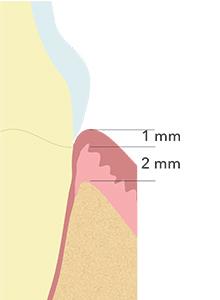From understanding the anatomy of the tooth to utilising the right tools and maintaining proper technique, mastering the art of tooth preparation is essential. Here are some key tips and techniques to help you achieve the most optimal outcomes.
Minimally invasive preparation
- The draft angle should stay < 10° (being 5° per face)
- The more the surface and height increase, the more the retention increases
- The higher the number of opposing walls, the more the retention increases
Dentine replacements and undercuts
- Use fibre-reinforced flowable composite (everX Flow) to fill the undercuts and/or replace dentine while preventing crack propagation.

The biological space must absolutely be respected for crown preparations
Respect the biology
- Defined by Gargiulo (1961) and Vacek (1994) the biological space must absolutely be respected for crown preparations
Immediate dentine sealing (IDS)
- Perform immediate dentin sealing to protect the dentin from contamination, avoid postoperative sensitivity and increase bond strength (G2-BOND Universal or G-Premio BOND). In case of Immediate Dentin Sealing, adhesive luting is mandatory
Temporisation
- Quickly and efficiently temporise the preparation with Tempsmart DC or Revotek LC


